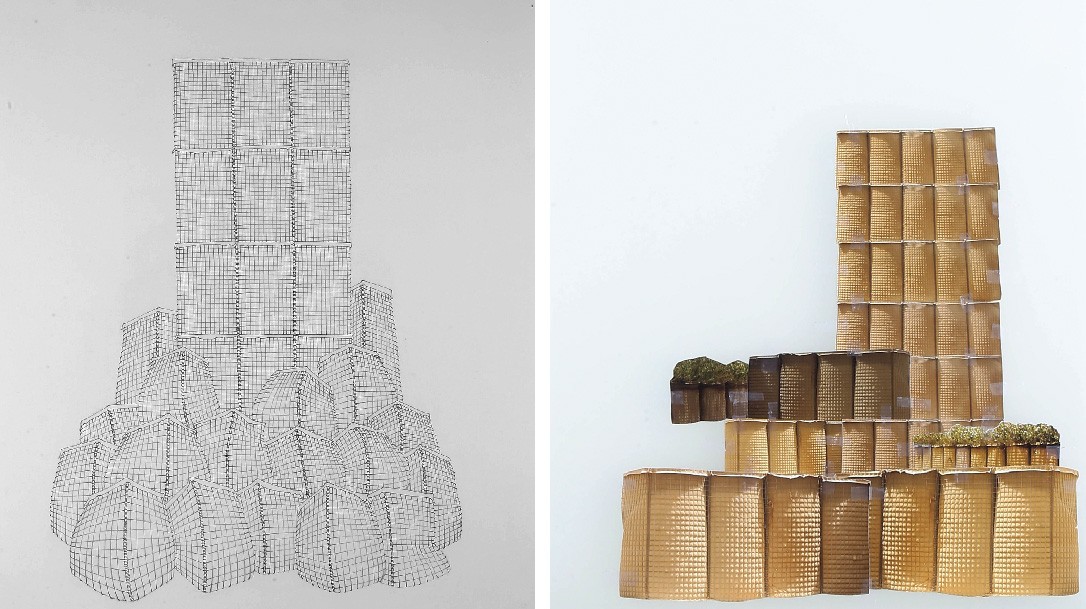
Seema Nusrat probes the transformation of spaces in her solo show at the Koel Gallery, Karachi

Peter Sloterdijk in his book In The World Interior Of Capital observes: "The primary fact of the modern age was not that the earth goes around the sun, but the money goes around the earth".
In the post 9/11 world, it seems that along with cash it is terror that rotates around the globe. You may be shopping in Damascus, sitting at a café in Tunisia, walking on a street in Alexandria, watching a football match in Paris or travelling in a cab in Brussels, you can become victim of suicide attacks perpetrated by groups operating beyond borders.
If a man who died in 1970s comes back to life today, he would be shocked to witness how life has transformed in this country. How the architecture is not about aesthetics, structural details or choice of material but a reflection of the psyche of a people facing the spectre of extremism. As layers of security structures -- with raised boundary walls, barbed wires, metal gates and sandbags -- are erected in our public buildings and private houses, no one even questions their presence or relevance.
Seema Nusrat has probed this transformation of spaces in her solo show ‘New Urban Landscapes’ held from April 7-18, 2016 at the Koel Gallery, Karachi. The exhibition, curated by Zarmeene Shah, comprised a total of 29 mixed media works and graphite on paper. For a sculptor who has been involved in exploring the physicality of material, to move away from a three-dimensional form that invokes a sense of touch and to venture into a detached body of work (enclosed, in most cases, within glass and wooden frames), is a significant step. Not only is it a reflection upon the changing landscape of our civic surroundings, it modifies the artist’s own practice.
In her one-person show, Nusrat has displayed collages of photographs on papers, and sensitive linear drawings -- some large scale. In both, the artist has tried to render an altered reality, in which an object of danger becomes an endearing entity. She has combined pictures of sacks to depict how the ideas of forms, functionality and fear meet/merge at one point. She talks about the way barriers put outside important buildings are now converted into planters (explained by the curator: "a new kind of barricade ….. Hesco Bastion, which took the shape of a collapsible wire mesh containers").
The usage of these items confirms the way grim situations end up being domestic, familiar and routine-like. She has cut and combined portions of these sacks in the form of small towers, which can protect you from militants’ attacks and explosions.
Seema Nusrat has created a number of compositions with overlapped security bags as motif, but one finds a repetitive element in her collages and drawings. It might be the result of a desire to display every piece made by her, or it could be an artistic response to the ubiquity of security-related stuff which, like the potential attacks, is equally destroying the normal course of living. The threat looms like a dark shadow in our surroundings, thoughts and even dreams. No matter how barricaded your environment, you are not safe. Hence, one converts these hideous but necessary objects into substances to live with -- by growing plants inside them.
A similar content can be comprehended in Nusrat’s drawings, in which arches, facades and doors are devoured by these sacks of security. Sensitive lines map the contours of built structures submerged in the outlines of open sacks. In some of these drawings, Nusrat has weaved houses upon houses which are facing the risk of invisibility at the hands of higher and higher boundary walls.
In that sense, the artist is like a prophet or a magician who professes what lies in future. It reminds one of Italo Calvino, who in his Invisible Cities fabricates imaginary places. A novel written in 1972 aptly describes our current scenario, especially when the author mentions: "Those who arrive at Thekla can see little of the city, beyond the plank fences, the sackcloth screens, the scaffolding, the metal armatures…..".